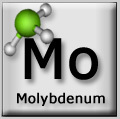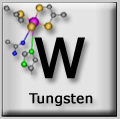Molybdenum, Tungsten


The availability of molybdenum from the sea today is relatively high in comparison to other metals, and at physiologically relevant pH it can be found in several oxidation states.
This makes it useful for electron transfer processes.
The similarity of the ionic radii of MoO42- (2.5 Å) and the physiologically relevant ions sulfate, SO42- (2.3 Å), and hydrogenphosphate, HPO42- (2.4 Å) makes the absorption of molybdenum through the corresponding ion channels plausible.
Biochemically, molybdenum is used diversely. Molybdenum centers are found in oxygen transfer enzymes (Molybdopterin cofactor), reductases, dehydrogenases, and in the cofactor of nitrogenases.
Tungsten is an extremely rare metal of secondary biological significance.
However, a few enzymes containing tungsten have been found recently in bacteria. The metal is generally found in a chemical environment similar to that found for analogous molybdenum enzymes.
